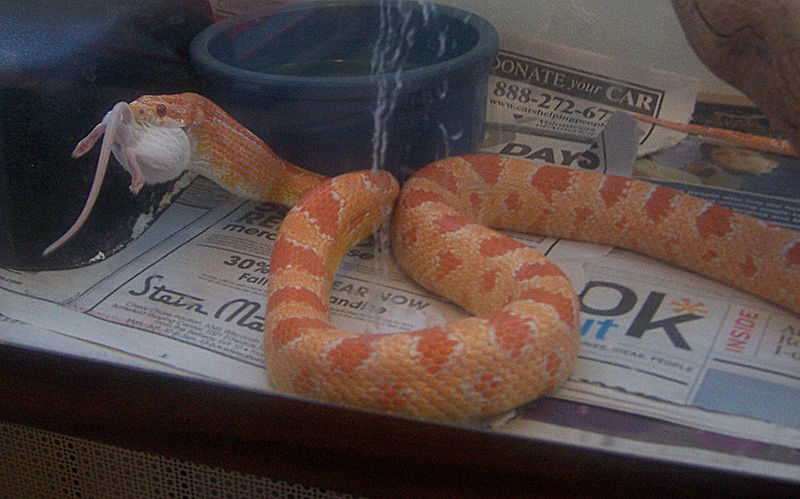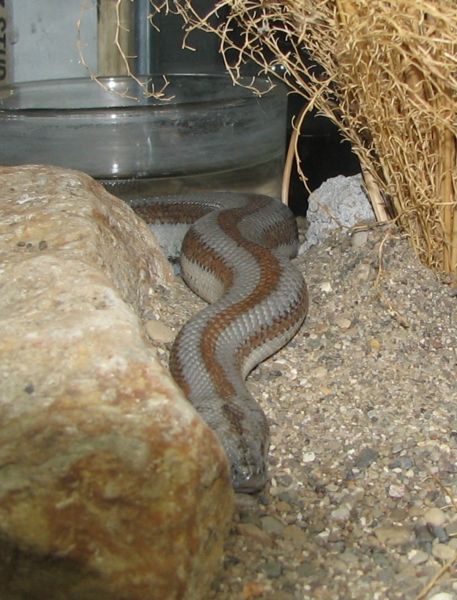The Green Tree Python tops the “must have” list of many snake-enthusiasts…and with good reason. Few snakes can match their gorgeous coloration, and an arboreal lifestyle adds an interesting twist to typical python care. Being moderately-sized, they are easier to accommodate than larger pythons, and captive breeding and life-spans of 20+ years are possible.
Enthusiasts and Fanatics
 Certain herps seem to arouse intense passions in their keepers, and folks drawn to them often become specialists (or fanatics, depending upon whom you ask!). Common examples include Arrow Poison Frogs and monitors. Among snakes, the Green Tree Python, Morelia viridis, seems to have more die-hard fans than most others.
Certain herps seem to arouse intense passions in their keepers, and folks drawn to them often become specialists (or fanatics, depending upon whom you ask!). Common examples include Arrow Poison Frogs and monitors. Among snakes, the Green Tree Python, Morelia viridis, seems to have more die-hard fans than most others.
Many years ago, when we knew little about their needs, I cared for a group of Green Tree Pythons that had been confiscated and re-routed to the Bronx Zoo. I searched about for an expert and soon came upon a zookeeper who was making great strides. Some of his co-workers, however, believed that his deep interest was causing him to, shall we say, give “less than perfect” care to his other charges. As the story goes, they set up a plastic Civil War battlefield in one of his frog exhibits…and it went unnoticed for weeks! I cannot attest to the truth of the tale, but I know of many others who evince a similar “one-mindedness” when working with these intriguing snakes.
Natural History
Green Tree Pythons are native to New Guinea, several Indonesian islands, and Australia’s Cape York Peninsula.
 Adults inhabit rainforest interiors, while juveniles favor forest edges and clearings, where their bright colors offer camouflage among flowers and sunlit foliage (please see habitat photo). They rarely if ever descend to the ground.
Adults inhabit rainforest interiors, while juveniles favor forest edges and clearings, where their bright colors offer camouflage among flowers and sunlit foliage (please see habitat photo). They rarely if ever descend to the ground.
Green Tree Pythons are ambush predators, relying upon sensory pits in the upper lip to detect prey. Youngsters attract lizards to within striking range by waving their tail tips in imitation of an insect (caudal luring). Adults feed upon arboreal possums, rodents and bats. While birds would seem likely additions to their menu, field studies have failed to establish that they are taken.
Juveniles may be red (New Guinea), yellow or brown. Most adults are emerald green and flecked with white, but some are yellow or blue. Albino, blue and other morphs have been developed by hobbyists. Adults average 4-5 feet in length, with rare individuals approaching 7 feet.
These nocturnal reptiles ambush their prey. When hunting, they extend the first third of the body outward while remaining anchored to a branch with the prehensile tail.
Housing
Setting up the Terrarium
Cage height is desirable, but length and width are more important, as Green Tree Pythons move over branches, but not down to the floor. Although rather sedentary, they should not be crowded. An enclosure measuring at least 3 x 2 x 2 feet will accommodate an average adult.
Terrariums that open from the front are preferable to aquariums, as Green Tree Pythons are stressed by approaches from above (perhaps due to the attack style of birds of prey, their major predators). In front-opening terrariums, they will often remain on their perches while the cage is serviced – sparing snake and snake-keeper stress and injury!
Well-anchored branches of varying widths, both forked and straight, should be installed. Sturdy live plants such as pothos and philodendron may be hung about to provide security and aid in humidity control. Artificial plants can also be used to create barriers behind which the snakes can hide. The bottom of the cage should be bare, to facilitate quick cleaning.
Substrate
Newspapers and washable terrarium liners work well as substrates. Douglas fir or eucalyptus bedding allows for easy “spot cleaning” and will raise the humidity if kept moist.
Light
Green Tree Pythons do not require UVB light, but a full spectrum bulb will bring out the true beauty of their coloration. A day/night schedule of 12:12 hours should be maintained. Red/black reptile “night bulbs” will allow you to observe their nocturnal behavior.
Heat
Incandescent bulbs should be used to maintain a temperature range of 78-85 F, and a basking spot of 88 F.
Night-time temperatures should not dip below 70-72 F. A ceramic heater or red/black reptile “night bulb” can be used to provide heat after dark.
Humidity
These rainforest denizens require an average humidity level of 50-75%. High humidity is especially important at shedding time. Humidity can be increased via manual spraying, moistening the substrate or a commercial reptile mister.
Constant wet conditions will lead to skin diseases, so the cage should have ample air flow and dry out completely after being misted.
Feeding
Green Tree Pythons are best offered food via tongs, as pre-killed rodents left on a branch are often ignored. Slowly moving the food in front of the snake, or lightly touching the jaws or body, often induces a strike. Juveniles feed primarily upon lizards in the wild, and many refuse mice at first. “Scenting” rodents with a lizard or shed lizard skin may be helpful.
Green Tree Pythons are relatively inactive, and seem to have an extremely efficient (even by snake standards!) digestive system. They need comparatively little food. Hatchlings should be fed every 5-7 days; juveniles every 7-10 days. Depending upon their size, adults require 1-2 mice or a small rat every 10-14 days.
While some individuals will accept an elevated bowl, most Green Tree Pythons prefer to drink water sprayed onto their bodies and the foliage; their typical resting position allows water to accumulate among the coils. Some will drink from a watering can that is tilted in front of their mouths (place a bowl below to catch excess water).
Handling
Green Tree Pythons will bite if forcibly removed from their perches, and have therefore gained a reputation for aggressiveness. Detachable perches simplify handling, as many individuals will remain immobile if perch and snake are relocated together. Some will even move from their perch onto an arm that is placed below, but in general they are best considered as snakes to observe rather than handle.
Further Information
Breeding pair and hatchlings on video
Breeding Green Tree Pythons at the Houston Zoo
Natural History and Local Lore (World Association of Zoos & Aquariums)
GTP image referenced from Wikipedia and posted by Micha L. Rieser
Habitat image referenced from Wikipedia and posted by Adam J.W.C.
 That Reptile Blog – Reptile, Amphibian and Exotic Pet Care and Information
That Reptile Blog – Reptile, Amphibian and Exotic Pet Care and Information



